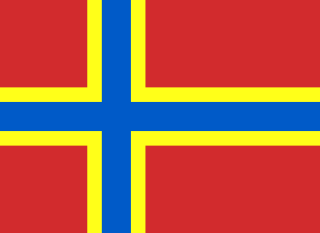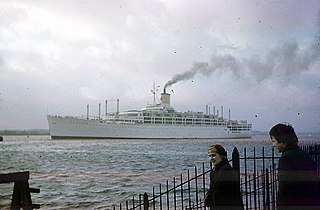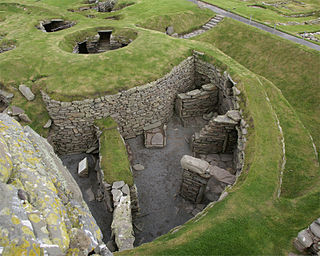
Orkney, also known as the Orkney Islands, is an archipelago in the Northern Isles of Scotland, situated off the north coast of the island of Great Britain. Orkney is 10 miles (16 km) north of the coast of Caithness and has about 70 islands, of which 20 are inhabited. The largest island, Mainland, is often referred to as "the Mainland", and has an area of 523 square kilometres (202 sq mi), making it the sixth-largest Scottish island and the tenth-largest island in the British Isles. The largest settlement and administrative centre is Kirkwall.

Thule is the farthest north location mentioned in ancient Greek and Roman literature and cartography. Modern interpretations have included Orkney, Shetland, northern Scotland, the island of Saaremaa (Ösel) in Estonia, and the Norwegian island of Smøla.
The Queen of Orkney, today best known as Morgause and also known as Morgawse and other spellings and names, is a character in later Arthurian traditions. In some versions of the legend, including the seminal text Le Morte d'Arthur, she is the mother of Gawain and Mordred, both key players in the story of King Arthur and his downfall. Mordred is the offspring of Arthur's inadvertent incest with Morgause, the king's estranged half-sister. She is furthermore a sister of Morgan le Fay and the wife of King Lot of Orkney, as well as the mother of Gareth, Agravain, and Gaheris, the last of whom murders her.

The Northern Isles are a pair of archipelagos off the north coast of mainland Scotland, comprising Orkney and Shetland. The climate is cool and temperate and much influenced by the surrounding seas. There are a total of 26 inhabited islands with landscapes of the fertile agricultural islands of Orkney contrasting with the more rugged Shetland islands to the north, where the economy is more dependent on fishing and the oil wealth of the surrounding seas. Both have a developing renewable energy industry. They also share a common Pictish and Norse history. Both island groups were absorbed into the Kingdom of Scotland in the 15th century and remained part of the country following the formation of the Kingdom of Great Britain in 1707, and later the United Kingdom after 1801. The islands played a significant naval role during the world wars of the 20th century.

Britannia Prima or Britannia I was one of the provinces of the Diocese of "the Britains" created during the Diocletian Reforms at the end of the 3rd century. It was probably created after the defeat of the usurper Allectus by Constantius Chlorus in AD 296 and was mentioned in the c. 312 Verona List of the Roman provinces. Its position and capital remain uncertain, although it was probably located closer to Rome than Britannia II. At present, most scholars place Britannia I in Wales, Cornwall, and the lands connecting them. On the basis of a recovered inscription, its capital is now usually placed at Corinium of the Dobunni (Cirencester) but some emendations of the list of bishops attending the 315 Council of Arles would place a provincial capital in Isca (Caerleon) or Deva (Chester), which were known legionary bases.

Britannia Secunda or Britannia II was one of the provinces of the Diocese of "the Britains" created during the Diocletian Reforms at the end of the 3rd century. It was probably created after the defeat of the usurper Allectus by Constantius Chlorus in AD 296 and was mentioned in the c. 312 Verona List of the Roman provinces. Its position and capital remain uncertain, although it probably lay further from Rome than Britannia I. At present, most scholars place Britannia II in Yorkshire and northern England. If so, its capital would have been Eboracum (York).

Maxima Caesariensis, also known as Britannia Maxima, was one of the provinces of the Diocese of "the Britains" created during the Diocletian Reforms at the end of the 3rd century. It was probably created after the defeat of the usurper Allectus by Constantius Chlorus in AD 296 and was mentioned in the c. 312 Verona List of the Roman provinces. Its position and capital remain uncertain, although it was probably adjacent to Flavia Caesariensis. On the basis of its governor's eventual consular rank, it is now usually considered to have consisted of Augusta or Londinium (London) and southeastern England.

Flavia Caesariensis, sometimes known as Britannia Flavia, was one of the provinces of the Diocese of "the Britains" created during the Diocletian Reforms at the end of the 3rd century. It was probably created after the defeat of the usurper Allectus by Constantius Chlorus in AD 296 and was mentioned in the c. 312 Verona List of the Roman provinces. It seems to have been named after Chlorus's family and was probably located beside Maxima Caesariensis, but their positions and capitals remain uncertain. At present, most scholars place Flavia Caesariensis in the southern Pennines, possibly reaching the Irish Sea and including the lands of the Iceni. Its capital is sometimes placed at Lindum Colonia (Lincoln).
Humans have inhabited Orkney, an archipelago in the north of Scotland, for about 8,800 years: archeological evidence dates from Mesolithic times. Scandinavian clans dominated the area from the 8th century CE, using the islands as a base for further incursions. In the late 14th century the archipelago became part of Scotland.

The Congregation of the Sons of the Most Holy Redeemer, commonly known as the Transalpine Redemptorists or The Sons, are a religious institute of the Catholic Church canonically erected in the Roman Catholic Diocese of Aberdeen and based on Papa Stronsay in the Orkney Islands, Scotland, as well as in the city of Christchurch, New Zealand. They were formed in 1988 as a traditionalist offshoot of the Redemptorists, following a monastic rule based on that of St. Alphonsus Liguori, and was later formally erected as a religious institute in 2012.
Murdoch Mackenzie, FRS (1712–1797) was a Scottish hydrographer and cartographer. He is known for his survey of the Orkney Islands: the subsequent maps, known as the Mackenzie Charts are still in use. He is also credited with the invention of the station pointer, a navigational and survey tool used to plot the horizontal angle fixes made with a sextant onto charts.

German submarine U-172 was a Type IXC U-boat of Nazi Germany's Kriegsmarine during World War II. She was first assigned to the 4th U-boat Flotilla for training and on 1 May 1942 was reassigned to the 10th flotilla, an operational long-range organization.

SS Orcades was built in Germany and launched as Prinz Ludwig. Served on routes to Asia until laid up in Germany during the 1914-1918 War. As part of war reparations Prinz Ludwig came under control of the British Shipping Controller in 1919 and was used for troop repatriations to Australia.

SS Orcades was an ocean liner serving primarily the UK – Australia – New Zealand route. She started service as a British Royal Mail Ship (RMS) carrying first and tourist class passengers. Orcades carried many migrants to Australia and New Zealand and was later used as a cruise ship, and is featured in the British Pathe films "I am a passenger" on youtube. She also made several voyages from Canada (Vancouver). "Orcades" is the Latin name for the Orkney Islands.

RMS Orcades was a British passenger ship that Vickers-Armstrongs Ltd of Barrow-in-Furness built as an ocean liner in 1937. Her owner was Orient Line, which operated her between Britain and Australia 1937–39, and also as a cruise ship. The Admiralty then requisitioned her and had her converted into a troopship.
The History of Shetland concerns the subarctic archipelago of Shetland in Scotland. The early history of the islands is dominated by the influence of the Vikings. From the 14th century it was incorporated into the Kingdom of Scotland, and later into the United Kingdom.

Prehistoric Shetland refers to a period in the human occupation of the Shetland archipelago of Scotland that was the latter part of these islands' prehistory. The period of prehistory prior to occupation by the genus Homo is part of the geology of Scotland. Although some written records refer to Shetland during the Roman invasions of Scotland, prehistory in Shetland does not end until the later part of the Early Historic Period in Scotland, around AD 900.

The modern names of Scottish islands stem from two main influences. There are many names that derive from the Scottish Gaelic language in the Hebrides and Firth of Clyde. In the Northern Isles most place names have a Norse origin. There are also some island place names that originate from three other influences, including a limited number that are essentially English language names, a few that are of Brittonic origin and some of an unknown origin that may represent a pre-Celtic language. These islands have all been occupied by the speakers of at least three and in many cases four or more languages since the Iron Age, and many of the names of these islands have more than one possible meaning as a result.

Vespasiana was a fictional 4th-century Roman province in Caledonia that appeared in Charles Bertram's 18th-century forgery On the State of Britain, which purported to be "Richard of Westminster"'s 14th-century retelling of a Roman general's contemporary account of Britain in late antiquity.

Gun Margoth Moberg was a Swedish photographer and artist who worked in Scotland. Her work includes photographs featuring the Orkney, Shetland, and Faroe Islands.












